Pseudo mosaic tiles
The idea is fiendishly simple. Why go to all the trouble of placing lots of mosaic tesserae if you can just put down tiles that give the appearence of mosaic? It was first used in medieval times, when a tile would be scored with lines to make it look as though it was made up of a number of pieces, and was revived in the Victorian era. In the 1860s, the firm Maw and Company took out a patent on a process for producing pseudo mosaic tiles. The method involved making a tile with grooves - these were then filled with cement, to look like grout.
You can see the pseudo mosaic effect in the example below, found in a doorway in Faversham, Kent. Each of these square tiles has 150 to 200 mosaic elements (the one on the left looks oblong, but it's an optical illusion). Other tiles, with black and grey "tesserae" in a grid pattern make up the outer border.
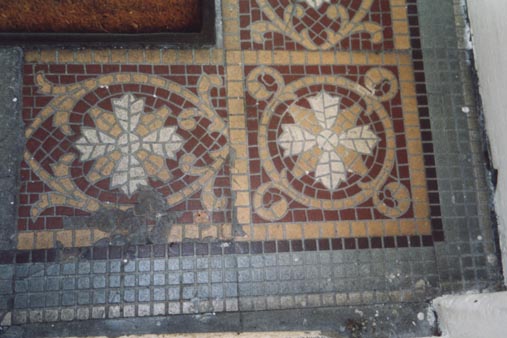
The second example is a much more complicated design. There is a wider range of colour and style. Look closely and you'll see that the "crazy paving" tiles on the left actually have irregular, interlocking edges to disguise the tiling effect. If you're having trouble picking out the repeating tiles, a hint is that the picture is three and a half tiles from top to bottom. To the right is a different tile, with the effect of guilloche - the twisted rope pattern found in many Roman mosaics - and then a regular grid border. This doorway is in Tavistock, Devon. (Use the links on this page to see more pictures of these tiles.)
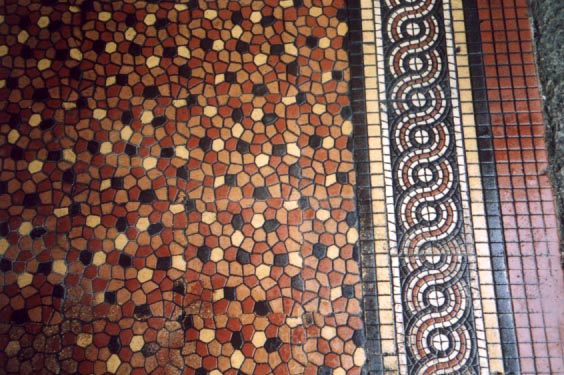
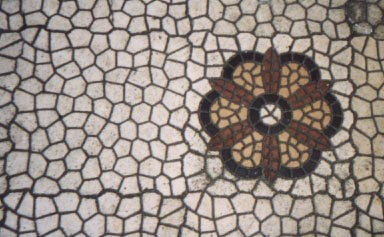 A similar crazy paving effect is used in this doorway
in Cromer,
Norfolk. The photograph shows two tiles, a plain white one on
the left and one with a flower pattern on the right.
A similar crazy paving effect is used in this doorway
in Cromer,
Norfolk. The photograph shows two tiles, a plain white one on
the left and one with a flower pattern on the right.
Here's another interlocking tile, from a doorway in York. The side edges are zigzagged while the top and bottom are smoother curves. The overall effect is a classical fan mosaic pattern, as in the left of the picture. However, to the right, where the tiles have taken more traffic, the raised parts have been completely worn away and the pattern lost.
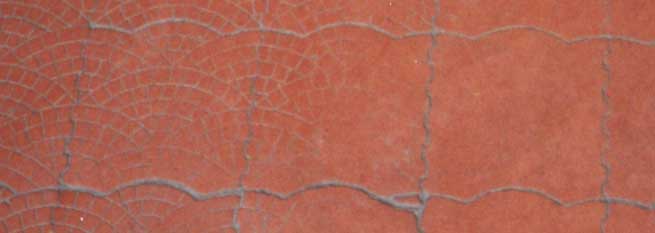
These Victorian pseudo mosaic tiles seem to have something of a design flaw that makes them less hard-wearing. The doorway below, in Norwich, shows how areas of heavy foot traffic have suffered, and the desired effect has been spoilt. After perhaps 100 years of service, these tiles disappeared in October 2003.
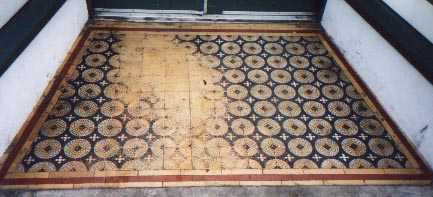
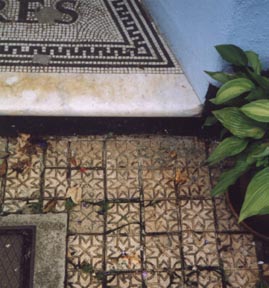 Surely the time is ripe for a revival
in this idea, and as a footnote, here's a decorative, almost
pseudo mosaic, effect. These are grooved tiles, designed to make
the path less slippery, but they complement the mosaic doorstep.
Even the drain cover at bottom left has a crisscross pattern.
Surely the time is ripe for a revival
in this idea, and as a footnote, here's a decorative, almost
pseudo mosaic, effect. These are grooved tiles, designed to make
the path less slippery, but they complement the mosaic doorstep.
Even the drain cover at bottom left has a crisscross pattern.
the joy of shards Mosaics Resource